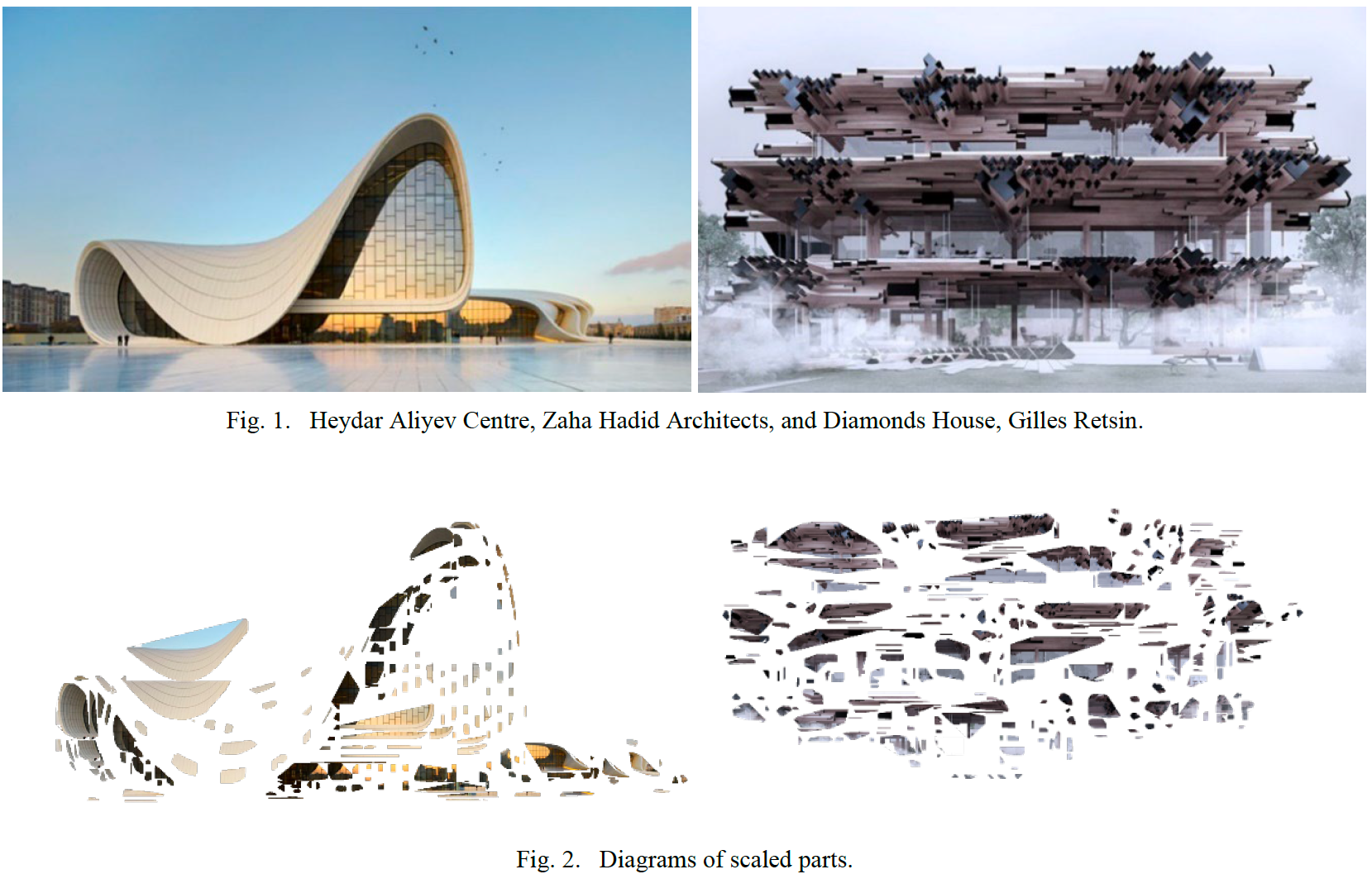Aesthetic Measure of Architectural Photography utilizing Computer Vision: Parts-from-Wholes
Abstract
The existing methods for solution space navigation require numerical values to score solutions. The authors introduce a method of quantitative aesthetic evaluation utilizing Computer Vision (CV) as a criterion to navigate solution spaces. Therefore, aesthetics can complement structural, environmental, and other quantitative criteria. The work stands in the extended history of quantifying the visual aesthetic experience. Some precedents are: Birkhoff [1933] and Max Bense [1965] built an approach with experiments to empirically support a measure, whereas Birkin [2010], Ostwald, and Vaughan [2016] devised the first computational methods working on vector drawings. Our research automates and accelerates aesthetic quantification by utilizing CV to extract computable datasets from images. We are especially keen on architectural images as a shorthand to assign an aesthetic value to design, aiming to navigate the solution space in architecture. This work devises a method for rearranging parts in architectural images focusing on formal aspects, in opposition to semantic segmentation where objects unrelated to architectural design (cars, persons, sky…) are quantified to score images [Verma and Jana and Ramamritham 2018]. It uses Maximally Stable Extremal Regions (MSER) [Matas 2004] to recognize architectural parts because it is superior to similar methods such as SimpleBlobDetector in this task. Our method disassembles the parts in a diagram of scaled parts (Fig. 2) to analyze them in isolation, and a diagram of connectivity graph (Fig. 3), to evaluate relationships. These diagrams are examined to compare photos of buildings, cars, and trees to assess the applicability of such a method to a range of objects. Parts and connections are thus quantified, and these values are inputted in a refined version of Birkhoff’s formula to calculate an aesthetic score for each image for navigating the solution space. Finally, it tests the method to draw comparisons between the discrete and continuous paradigms (Fig. 1) in the contemporary discourse of architecture, comparing Zaha Hadid Architects` Heydar Aliyev Centre and Gilles Retsin´s Diamonds House to argue that there is a difference between the aesthetic effects of continuous and discrete designs, besides their distinction in tectonic logic. The method proved to be an efficient procedure for comparatively quantifying the aesthetic judgment of architectural images, enabling designers to incorporate aesthetics as a complementary criterion for solution space navigation in computational design. The method of computational aesthetic measure for solution space navigation and its calibrations via crowdsourced evaluation of images is further detailed in a paper by the authors being published at the 2022 eCAADe conference.
Keywords
Quantitative Aesthetics, Aesthetic Measure, Computational Aesthetics, Parts-to-whole Relationship.
Bibliography
- BENSE, M. 1965. Aesthetica. Einführung in die neue Ästhetik. agis.
- BERLYNE, D. E. 1973. Aesthetics and Psychobiology. Journal of Aesthetics and Art Criticism 31 (4):553-553.
- BIRKHOFF, G. D. 1933. Aesthetic Measure. Harvard University Press.
- BIRKIN, G. 2010. Aesthetic Complexity: Practice and Perception in Art & Design. Ph.D. Thesis. Nottingham Trent University.
- ECHENAGUCIA, T. M. 2014. Computational Search in Architectural Design. Ph.D. Thesis. Politecnico de Torino.
- FECHNER, G. 1948. Elements of Psychophysics, 1860. In W. Dennis (Ed.), Readings in the history of psychology. Appleton- Century-Crofts.
- FOSTER GAGE, M. 2011. Aesthetic Theory: Essential Texts. New York: W. W. Norton.
- FRANZ, G. 2005 An Empirical Approach to the Experience of Architectural Space. MPI Series in Biological Cybernetics. N. 14, December 2005.
- GOLDSTEIN, E. B. 2008. Cognitive Psychology: Connecting Mind, Research, and Everyday Experience. Thomson Wadsworth.
- KIEMLE, M. 1967. Ästhetische Probleme der Architektur unter dem Aspekt der Informationsästhetik, Schnelle, Qickborn.
- MASER, S. 1970. Numerische Ästhetik: neue mathematische Verfahren zur quantitativen Beschreibung und Bewertung ästhetischer Zustände.
- MATAS J. 2004. “Robust wide-baseline stereo from maximally stable extremal regions.” In Image and Vision Computing Volume 22, Issue 10.
- OSTWALD, M. J. AND VAUGHAN, J. 2016. The Fractal Dimension of Architecture. Basel: Birkhäuser.
- ROTHER, C. AND KOLMOGOROV, V., AND BLAKE, A. 2004. "GrabCut": interactive foreground extraction using iterated graph cuts.” ACM Trans. Graph. 23, 3. DOI:https://doi.org/10.1145/1015706.1015720.
- STUART-SMITH, R. AND DANAHY, P. 2022 “Visual Character Analysis within Algorithmic Design” in POST-CARBON, Proceedings of the 27th CAADRIA 2022.
- THÖMMES, K. 2020. The Aesthetic Appeal of Photographs: Leveraging Instagram Data in Empirical Aesthetics, Ph.D. Thesis, Universitaet Konstanz.
- VERMA, D. AND JANA, A. AND RAMAMRITHAM, K. 2018. “Quantifying Urban Surroundings Using Deep Learning Techniques: A New Proposal,” in Urban Sci. 2018, 2(3), 78.
- WOODBURY, R. F. AND BURROW, A. L. 2015. “Whither design space?” in Artificial Intelligence for Engineering Design, Analysis and ManufacturingVolume 20 Issue 2 April 2006 pp 63–82 https://doi.org/10.1017/S0890060406060057.
